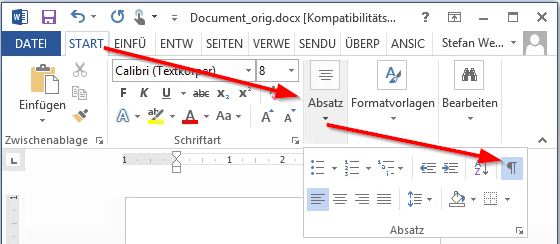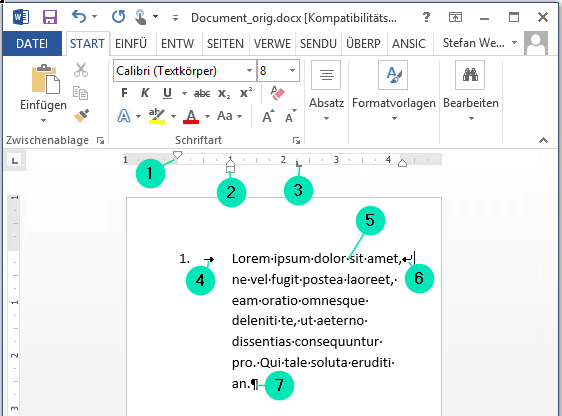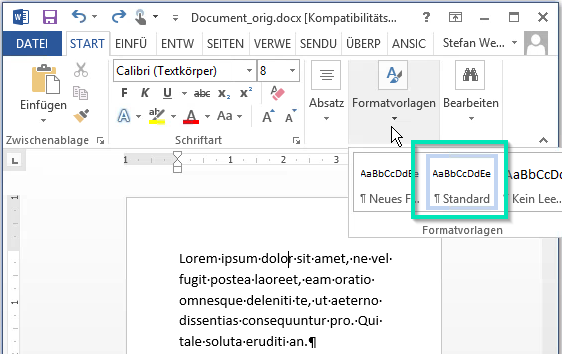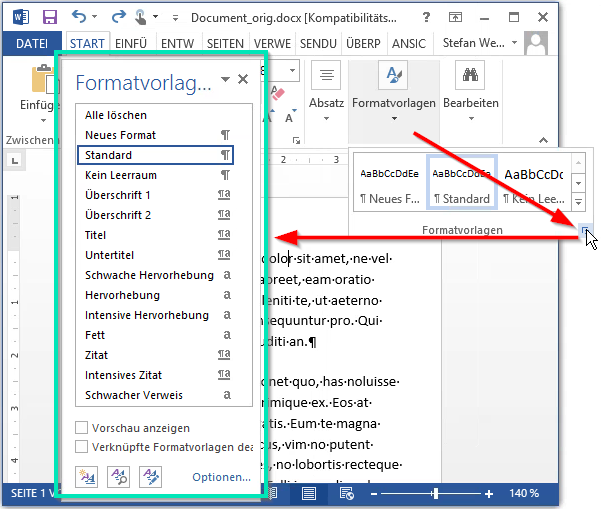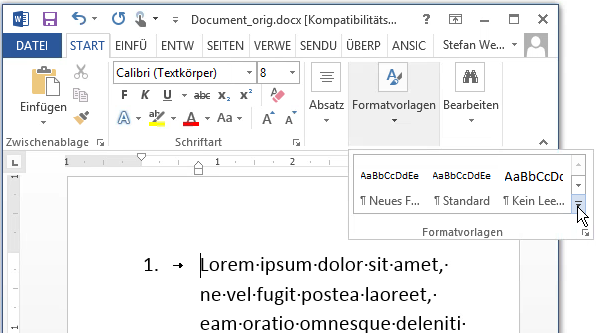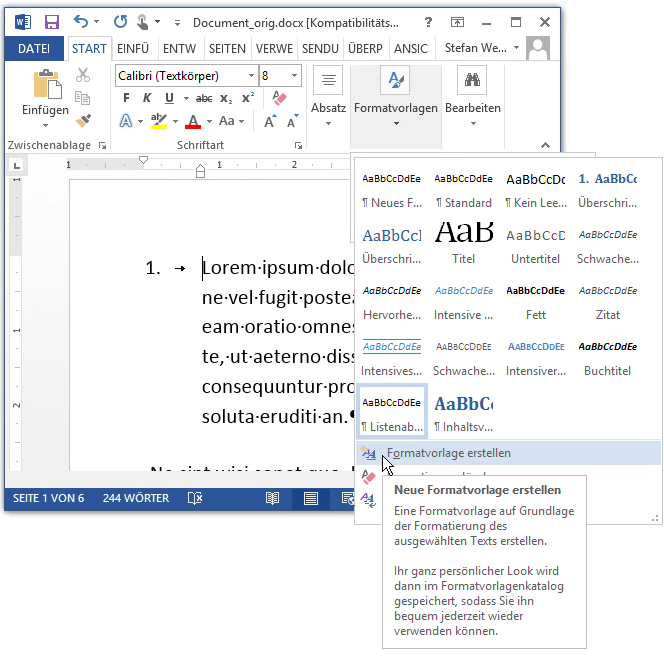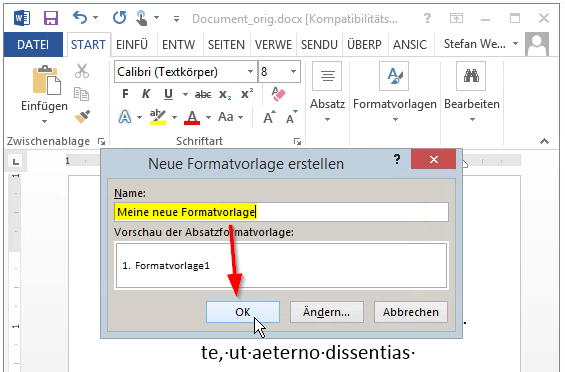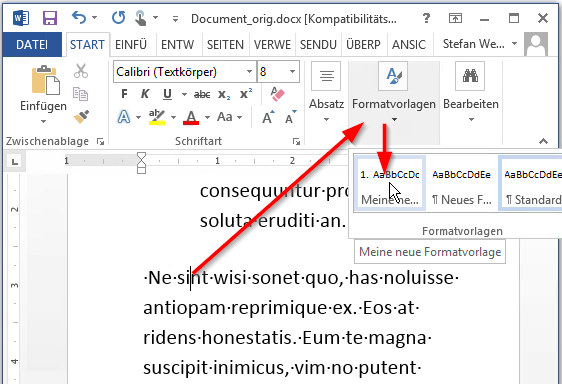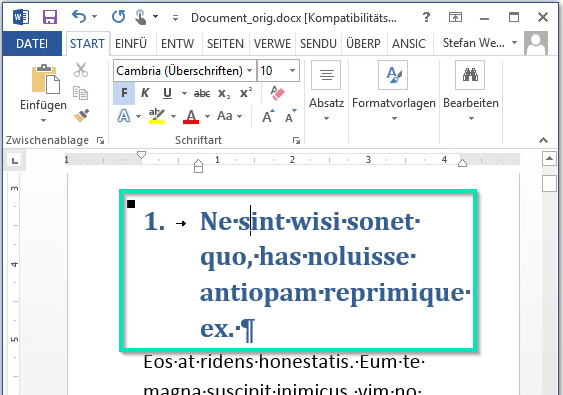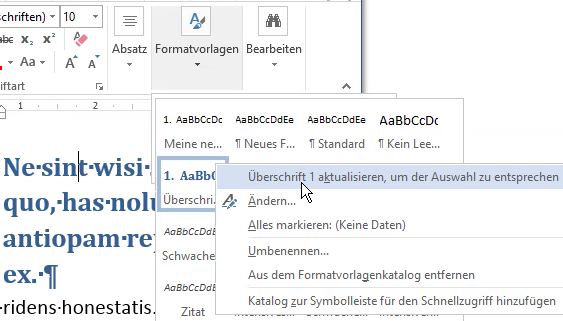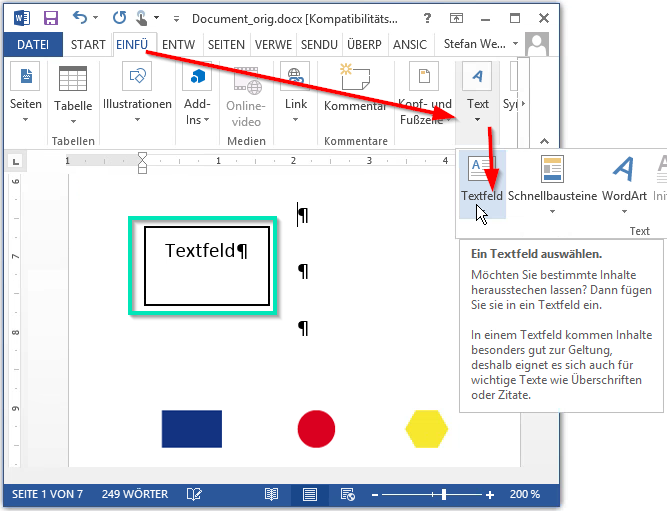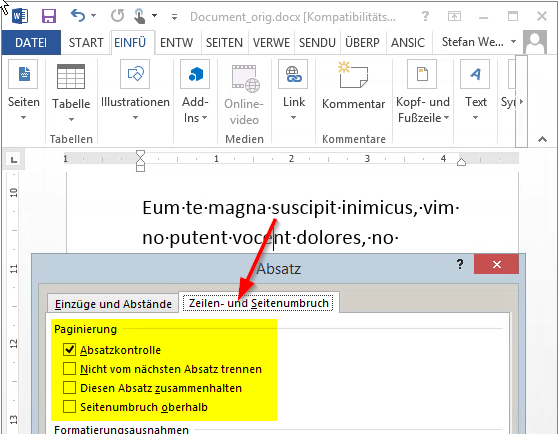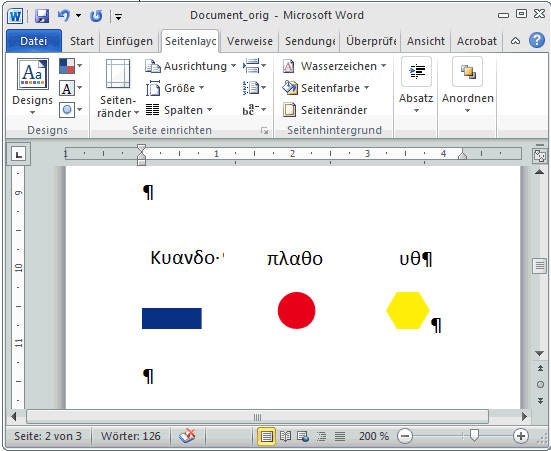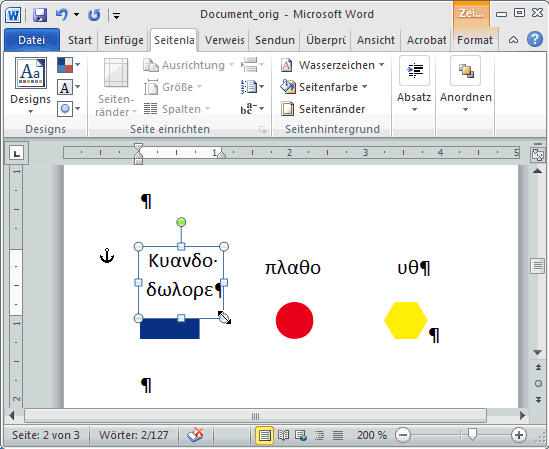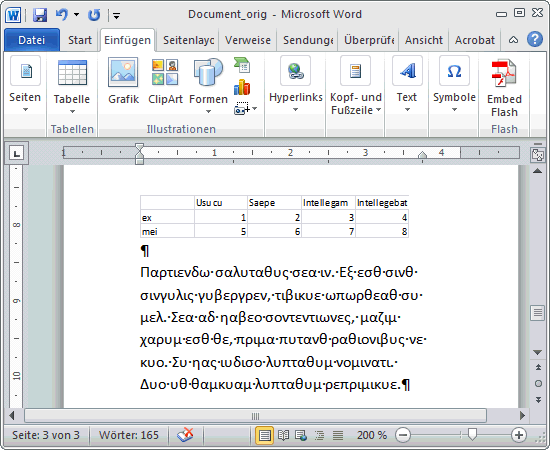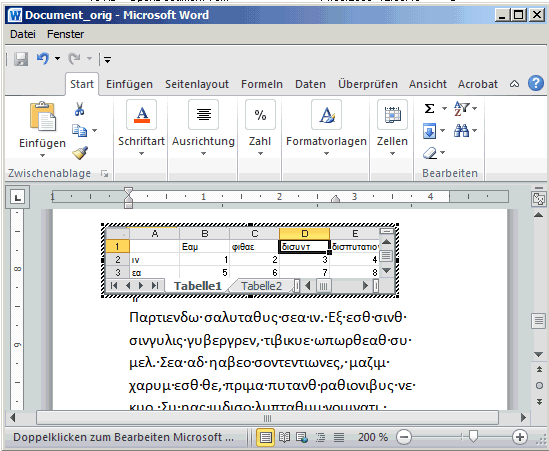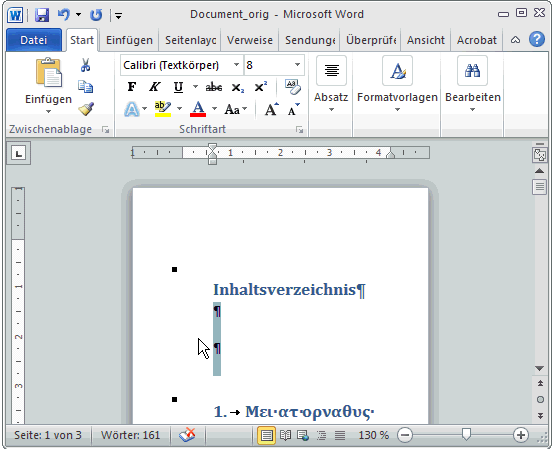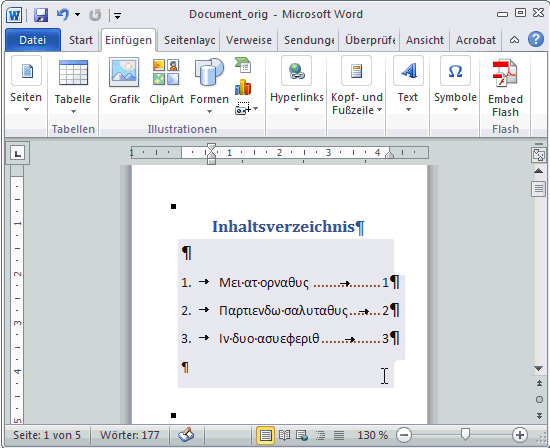Translation of Microsoft Word® files at PRODOC
Almost all our customers also entrust us with the translation of Word files and award us with the best credentials.
In general we use CAT tools for translation into many major languages.
This also applies to Microsoft Word® files!
The reason for this is the possibility to reuse translations made once. This can save considerable costs, especially for technical translations.
However, further savings can also be achieved with well-considered preparation and post-processing of translations (usually in-house). How this works is shown below.
Special features of Microsoft Word
User training that is often lacking
Authors often lack the necessary knowledge of Microsoft Word files to use paragraph and character formats properly. As well as the usual checks that are carried out in FrameMaker and InDesign, it should therefore also be checked whether formats have been used at all.
Problematic OLE functions
Another problem is created by the Microsoft Word OLE function. In embedded files, it must always be checked whether the files contain additional invisible text.
Optimization of Microsoft Word® files for translation
Necessary checks
With Microsoft Word files, more extensive checking is required before the start of translation in order to guarantee a smooth translation workflow.
As with the other programs, the control characters also need to be visible here.
Preparations: Show control characters
In Microsoft Word, you can show the control characters using a button in the menu bar.
The screen in Microsoft Word changes accordingly:
The control characters in the screenshot above have the following meaning:
- First row indent
- Left indent
- Tabulator position
- Tabulator characters in the text
- Space
- Line break
- Paragraph break
Points to check before translation
Manual formatting
Manual formatting often takes place in Microsoft Word, i.e. manual formats such as font and type size, line spacing and indents are manually assigned to individual paragraphs and characters without using formats.
Standard paragraph format
Manual formatting can usually be recognized from the fact that all paragraphs have the Standard format assigned to them.
Click in several paragraphs one after the other and examine the format name which is displayed in the menu bar at the top.
Effects on the translation
Manual formatting is not a problem in itself. The formats assigned here are also automatically assigned to the translated text.
However, in doing so you dispense with possible automated functions such as the automatic creation of a table of contents, the keeping together of images and their associated legends, tables and table titles etc.
Higher layout costs
With manual formatting, higher layout costs for the layout of the translated text are to be expected.
When a document is being translated into several languages, you should consider whether to carry out structured basic formatting prior to translation for cost-saving purposes.
Formatting with spaces
This applies in the same way as with Adobe FrameMaker.
We will show you how to improve formatting in the next section.
Use of style sheets and special characters in Microsoft Word files
Creating and using style sheets
Standard style sheets in Microsoft Word
With larger documents, it is also incredibly helpful to use paragraph formats in Microsoft Word files.
The paragraph formats which are available for use in the document are shown in the paragraph format list:
Standard formats Überschrift1 – Überschrift3 are available for headings, and can be adapted to your own needs.
Furthermore, depending on the contents of the document you should define your own paragraph formats for lists, indented text, captions, table titles etc.
The following chapter shows how to do this based on the standard stylesheet:
Creating style sheet
In the same way as enumeration formats in FrameMaker, you can also carry out the following formatting manually in Microsoft Word from the starting point of the Standard stylesheet.
Click on the small arrow as shown above with the cursor in the newly formatted paragraph.
Click on Neue Formatvorlage erstellen in the pop-up window.
The following window opens.
Enter a name for the new stylesheet in the Name field and save it by clicking on OK. Microsoft Word now creates a new stylesheet with the settings of the current paragraph.
Using paragraph formats
Place the cursor in the paragraph to be formatted and then click on the format you would like to assign in the style sheet list.
Customizing paragraph formats for headings in Microsoft Word
A table of contents can be generated automatically from the standard formats for headings (Überschrift1 – Überschrift3).
You should therefore use these formats and adapt them according to your requirements:
- Assign the heading format to be adapted for a paragraph.
- Then adapt the format to your needs.
In the following, Überschrift1 format was assigned to the current paragraph and manually adapted.
This numbering can now be transferred to all paragraphs formatted with Überschrift 1 as follows:
- Search for the
Überschrift1entry in the stylesheet list. - Click on the arrow for the drop-down menu at the right-hand edge of the entry and select
Aktualisierento adapt to the selection.
Use special characters
It is often desirable to keep certain character sequences in the same line. This applies to figures with units (e.g. 8 kg) as well as fixed expressions such as Adobe InDesign.
If you do not want DIN EN 15038-1 to appear on two different lines, you can insert non-breaking spaces and hyphens.
You can add a non-wrapping space with Ctrl+shift+space and a non-breaking hyphen withStrg+Umschalt+-.
In a Microsoft Word file this will look as follows:
Advantage: these characters are retained during technical translation using CAT tools. You therefore no longer need to check all occurrences of such character sequences for unwanted wrapping after translation.
You can find further information on this topic under Special characters.
Optimum incorporation of images in Word files
Incorporation of language-neutral images
Screenshots
In Microsoft Word, graphics are inserted into the document and fixed. There is therefore no elegant and easy way to replace German screenshots with foreign-language screenshots like there is with FrameMaker or InDesign.
A helpful measure for reducing costs is to insert the file names of inserted screenshots into the Microsoft Word file above or below the screenshot itself. This then helps the translator with the assignment of target-language screenshots.
Alternatively, the screenshots can be inserted in the target language before translation, provided that there is only one target language.
Dimensioned drawings, schematic diagrams…
Graphics inserted in Microsoft Word should not contain any language information whatsoever. The CAT tool cannot extract texts from inserted graphics, and these will not be translated.
Text boxes
Completely remove the text from the graphic and insert text boxes in the same location in Microsoft Word instead:
Optimizing embedded files (OLE) for translation
OLE = Object Linking and Embedding
Word contains more data than displayed
If you embed a Microsoft Excel file into Microsoft Word as an OLE, then the entire file is embedded and not just the part of this file that is displayed in Word.
Display in Microsoft Word
An example: You see the following Microsoft Excel table in Microsoft Word:
Microsoft Word – Displaying Excel files
Actual contained data
However, the Microsoft Excel table also includes the following text shown in red
Effects
Too much text in the CAT tool
The entire content of the Microsoft Excel file is read into the CAT tool and is therefore also translated. There is no option to just import the displayed text.
Measures for reducing costs
Double-click on the embedded file in Microsoft Word and delete all content that is not displayed.
Warning! This also applies to drawing sheets that are not displayed which may be contained within Excel and Visio files.
PRODOC’s translation service for Microsoft Word files
Complete service with translation and layout
We would be pleased to take over the entire layout for you. The related costs are shown in our quotes as a separate item.
However, we would like to explicitly state that Microsoft Word specifies the page break on the basis of the local print drivers. Furthermore, there are many options for automatic formatting in Microsoft Word that can change the appearance of a document.
This may lead to a file looking different if it is opened on different computers. In any case, the Microsoft Word file needs to be checked before printing or creating a PDF file.
Info about printing problems in Word can also be found in the following article from CNET.
Translation only
If you would like to deal with as much of it as possible yourself in order to cut down external costs, you can also commission technical translation only.
We then supply a pre-formatted Word file that you can finish off yourself.
Workflow for technical translation of Word files at PRODOC
For you as a customer the effort is conceivably low. You only have to provide the required files. We’ll take care of the rest!
- If the files to be sent are > 5MB, please let us know. If this is the case, do not send the files by e-mail.
In that case we will create a NextCloud user account for you with which we can exchange large files with you via a secure browser connection.
Receiving the Word files translated by PRODOC
If you have commissioned us to carry out the entire layout, you will then receive a ZIP file from us via email or NextCloud which you simply need to unpack in a suitable location. This contains the translated Word file and, if required, also a foreign-language PDF file which you can use directly.
If you have commissioned us to do translating only, you will only receive the Word file. You can find out how to generate a finished foreign-language file in the next section.
Layout of translated Microsoft Word files
Even if you have taken all the measures in advance in order to automate the layout of the translated text as far as possible, adjustments to the text and graphics are unavoidable due to differing text lengths.
The table of contents may also need to be updated and translations of OLE objects included.
Adapting the text flow
Adapting page breaks
Depending on the formatting settings and text lengths, the following may occur:
- Unwanted empty spaces
- Texts that belong together divided between two pages
Adapt the page break in accordance with your requirements. When doing this it is advisable to use the options for line and page breaks. These can be found by clicking the right mouse button in the current paragraph and select the Paragraph submenu.
Adjusting line breaks
Even if the correct spellcheck dictionary is already selected after processing with the CAT tool, unwanted separations may have occurred due to selecting unsuitable separation specifications.
Examine the ends of the lines in the document and correct any unwanted separations. The following may occur:
| Line break errors | Remedy |
| Separation of numbers and units | Insert non-breaking separator (ctrl+shift+space) |
| Separation of two words which are connected with a hyphen | Insert non-breaking hyphen (ctrl+_) |
| Unwanted word separation | Insert hard line break (shift+enter) |
Adapting text boxes
If text boxes were used to label graphics they may be too small.
It will then look like this:
As you can see, you can’t see anything. Microsoft Word has no professional display function for missing text, as is the case with Adobe FrameMaker and InDesign.
Instead, you must take great care to ensure that the end of paragraph character appears in all text boxes:
Even if you see the end of paragraph character, you should compare the translated text with the original because it is possible that there is another paragraph below the one that is being displayed.
Updating screenshots
Foreign-language screenshots are crucial for software localization
Naming foreign-language screenshots
You need to manually replace every inserted screenshot with the foreign-language screenshot in Microsoft Word.
A naming system is therefore beneficial if the text contains many screenshots in order to prevent unnecessary searching and assignment problems.
Replacing screenshot
Click on the screenshot in the Microsoft Word file and in the menu that appears click on Insert Picture.
Select the screenshot to be used in the Insert Picture window and insert it.
Updating OLE objects
After exporting from the CAT tool, text in OLE objects, such as Excel or Visio files, remain in the original language.
Double-click on the object:
The view of the embedded object has now been updated and the translated text is displayed.
Close the object again to save the changes to the display in the Microsoft Word file.
Repeat this process for all embedded files.
Displaying and updating the table of contents
After exporting from the CAT tool, there is normally no text where the table of contents should be.
Highlight the area where the table of contents should be:
Now press F9. The table of contents is generated and displayed.
We create all our operating instructions in Word. PRODOC translates these professionally into many different languages, including rare languages such as Latvian. We receive translated Word files preformatted by PRODOC and have very little effort in formatting them ourselves.
Microsoft Word® used by PRODOC customers
Many companies are using Microsoft Word® as an “all-purpose weapon” for the creation of a wide variety of text types. Unfortunately, it is generally assumed that every employee can work with Word. Targeted training for the respective purpose usually does not take place. Users are usually not prepared to create more complex documents in Microsoft Word
We therefore recommend FrameMaker for operating instructions and datasheets, whereas InDesign is the tool of choice for marketing documents.
Regardless of these recommendations, Microsoft Word® is popular across all industries and used by almost all of our customers










Request quoteNo matter if you want to take over the layout of the translated files yourself or if you want to receive formatted files: with PRODOC you have found the right partner for handling Word files!

Dipl.-Kffr. Sanne Jerxsen
Administrative director
